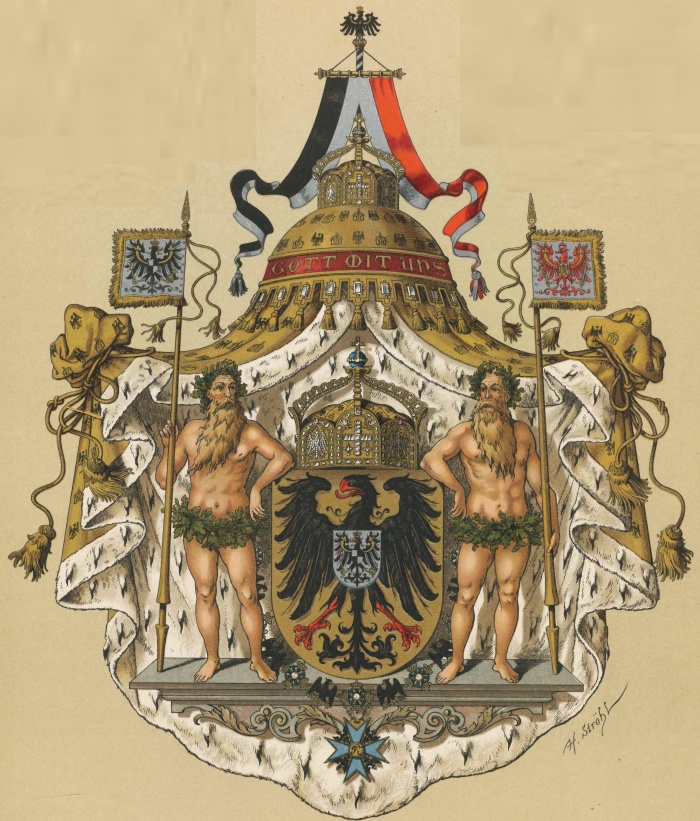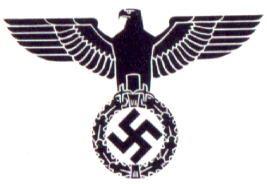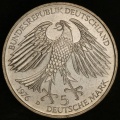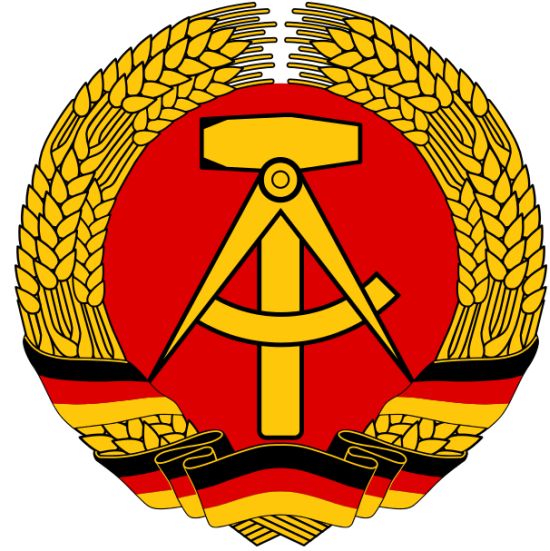The National Arms of Germany
NATIONAL COAT OF ARMS OF GERMANY
Origin/meaning
The present arms were officially adopted on January 20, 1950.The German eagle is already an old national symbol for the Kings and Emperors of Germany, or its predecessors (to make it easy, the former Empire is named Germany below, even though the name was not officially used until 1871).
Even though Charlemagne used an eagle as the national symbol around 800, he claimed to be the successor of the Roman Emperors, who already used an eagle, it was not until the end of the 12th century that the eagle was used in arms of the Emperors. Before the end of the 12th century the eagle sometimes appears as the national symbol, but mainly shown as a natural eagle.The first known use of the eagle as arms of the Emperor or the Empire is a coin, minted in Maastricht (now in the Netherlands), dating from between 1172 and 1190. It shows a single-headed eagle (see fig below).
| Coin from between 1172 and 1192, with the oldest known use of the eagle. |
The use of an eagle was not limited to the German Emperors, at the same time the Counts of Saarwerden and Henneberg, the Kings of Bohemia, the Dukes of Austria and others used an eagle in their arms or as their symbol. In the 13th and 14th century many other noble families also used an eagle.
The Imperial Eagle was also used by all free cities, throughout the empire, examples are Mosbach, Aalen and, outside present Germany, Deventer.
The colours of the Imperial Eagle are already known from the 13th century, as being a black eagle on a golden field. These colours are thus also used by practically all Imperial cities. The origin of the colours is not known. It may be derived from the colours of the Staufen dynasty, who were the ruling dynasty at the time the arms were adopted. In any case, the basic colours have not changed since. The claws, legs, beak and tongue gradually became red. The first mentioning of red legs date from the early 14th century. The Zürich roll of arms from 1335 also shows a red tongue. The beak does not become red until the 18th century. Completely black eagles appear at the same time during the centuries.
The arms were covered by a crowned helmet with an eagle as a crest until 1330. In 1330, under the reign of Ludwig of Bavaria, the eagle in the crest was replaced by the wings of the Wittelsbach family (his dynasty). These remained until the 15th century. Afterwards crests are rarely used.
The original arms showed a single-headed eagle. Germany was an Empire, but after the death of an Emperor first a nobleman was chosen as King of Germany. He could be promoted to Emperor, but that did not always happen. Gradually thus two different arms appeared, a single-headed eagle for the Kings and a double-headed eagle for the Empire and the Emperor. The first mentioning of a double-headed eagle dates from 1250 in a roll of arms of Matthew of Paris for Emperor Friedrich II. In the next 180 years both arms were used indiscriminately. Emperor Sigismund finally decided the difference between the arms for the King and the Emperor.
The double-headed eagle was used as the arms of the Empire ever since. The emperors themselves often used the eagle as a supporter for their own personal arms. An example is given below where the arms of the Emperor (Charles IV ?) are placed on the eagle. Above the eagle the Imperial crown is seen, the chain is from the Order of the Golden Fleece. This composition is also used by Imperial cities, such as Middelburg.
In 1871 Germany finally became a true State, instead of a loose combination of (hundreds of) states and territories. The new Imperial Arms were basically a combination of older traditions. As the rank of King was no longer used, a single-headed eagle was chosen. According to custom, the arms of the ruling dynasty were added as a breast-shield. Contrary to the older custom, the eagle was no longer used as supporter, but placed on the shield again. As the ruling dynasty as the Hohenzollern family, Kings of Prussia, the new arms were held by the Prussian savages as supporters, each holding a banner with the Imperial eagle.
| The Imperial arms of 1871 |
After the First World War, the new Republic removed all Prussian symbols, and used a plain single-headed eagle. The arms are identical as the present arms.
During the Nazi reign, the old heraldic arms were completely removed. The new national symbol, the swastika, was now held by a stylistic eagle. Even though the national state did not use arms, it was encouraged for local councils to adopt heraldic arms.
| The national symbol during the Nazi reign. |
Use of the arms
Different versions of the eagle on coins (all images form eBay):
GDR
After the Second World War Germany was divided into Western Germany and the German Democratic Republic. West Germany continued to use the old arms of the Republic.
The GDR did not use true arms, but a typical socialist logo. At first (in the 1950ies), it included only the garland of corn and the hammer. The garland of corn symbolised the farmers and the hammer symbolised the labourers, because the GDR was a land, which was governed by the labourers and farmers (according to the official propaganda) Later the compass was supplemented, which symbolised intelligence and fine industry.
| The national symbol of the GDR. |
After the reunification, the old West German arms were continued.
This page is part of the German heraldry portal Deutsche Wappensammlung |
Heraldry of the World |
|
German heraldry:
|
Selected collector's items from Germany:
|
Contact and Support
Partners:
Your logo here ?
Contact us
© 1995-2025, Heraldry of the World, Ralf Hartemink 
Index of the site
Literature:Stadler, K. : Deutsche Wappen - Bundesrepublik Deutschland. Angelsachsen Verlag, 1964-1971, 8 volumes; Schurdl, H. : Flaggen und Wappen Deutschland, 1995; Kalckhoff, A. : Fürsten-. Länder-, Bürgerwappen: Heraldik aus neun Jahrhunderten. Stuttgart, 1984.


























